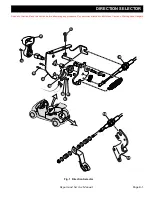
Page L-8
ELECTRICAL
Repair and Service Manual
Read all of Section B and this section before attempting any procedure. Pay particular attention to all Notices, Cautions, Warnings and Dangers.
In general, starter/generator service is best performed by
trained motor technicians who have the knowledge and equip-
ment to overhaul the unit. Some checks and repairs however,
can be accomplished by a skilled mechanic. Make your own
evaluation of the equipment and skills available before start-
ing disassembly.
Hold the pulley (1) and remove the pulley nut (2).
Remove the pulley, screws (4) and front cover (3) (Ref.
Fig. 7).
Remove the brush covers (6) by prying out with a
screwdriver. Pull up on the brush springs and move to
the side of brushes, slide the brushes out approximately
1/4" (6 mm) (Ref. Fig. 8). Remove the through bolts (7)
and the rear cover (8). Remove the frame and field coils
(9). Remove the 5 mm screws from the brush holder
and 6 mm nuts from A1 and A2 terminals. Remove the
brush holder. If the bearing needs to be replaced, use
an automotive style two jaw puller to remove the bear-
ing from armature (Ref. Fig. 9).
Fig. 8 Starter/Generator Brush Removal
Fig. 9 Bearing Removal
Repair and Replacement
1. Commutator - Clean with a soft, clean cloth.
2. Replace any damaged or cracked brush holders or
brushes worn to less than 11/16" (17 mm) in length or
to the line marked on the brush.
3. Test the insulation between the core and the commu-
tator segments and shaft with a circuit tester. If conti-
nuity is indicated, the insulation is defective and the
armature must be replaced.
4. With the brushes removed, using a DVOM, check the
field coils for continuity between ‘F1’ and ‘F2’ and ‘DF’
and ‘F1’. If an open circuit exists, replace the field
coils. Check for continuity between all four terminals
and the frame (outer shell). If continuity is indicated,
the field coils are grounded against the frame and the
field coils must be replaced.
5. Clean all parts to be reinstalled and reassemble in the
reverse order of disassembly. Tighten bolts and nuts
to the following values:
•
4 mm - torque to 15 - 21 in. lbs. (17 - 24 kg/cm)
•
5 mm - torque to 30 - 43 in. lbs. (35 - 50 kg/cm)
•
6 mm - torque to 52 - 74 in. lbs. (60 - 85 kg/cm)
•
14 mm - torque to 33 - 40 ft. lbs. (45 - 55 Nm)
Tighten
terminal nuts
to the following torques:
•
F1 - F2 - torque to 43 - 52 in. lbs. (50 - 60 kg/cm)
•
DF - torque to 26 - 35 in. lbs. (30 - 40 kg/cm)
BATTERY VOLTAGE TEST
Battery voltage can be checked using a voltmeter.
Attach the negative (-) lead of the DVOM to the ground
terminal of the battery. The positive (+) lead is then
attached to the positive battery terminal. The voltage
reading obtained should be 12 volts or above. If the
reading is below 12 volts, the battery requires either
charging or replacement.
Hydrogen gas formed during battery charging
is explosive and can cause personal injury or
death. Avoid any electrical spark or open
flame near battery.
If the temperature of the battery or the ambient temperature is
below 60
°
F (15
°
C), the capacity of the battery will be less. It
will require more time to charge. A cold battery will build up
voltage and more rapidly reduce the charging rate.
Batteries that are new or have been stored must be fully
charged before being tested or placed in vehicle.
Do not overcharge battery.
NOTICE
Brush
Brush
Spring
Spring Position
for Installed Brushes
Spring Position for
Removing/Replacing
Brushes
Brush
Puller
Bearing Adapter (Puller)
NOTICE
















































